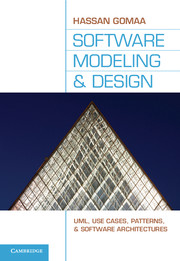Book contents
- Frontmatter
- Contents
- Preface
- Annotated Table of Contents
- Acknowledgments
- PART I Overview
- PART II Software Modeling
- PART III Architectural Design
- PART IV Case Studies
- 21 Client/Server Software Architecture Case Study
- 22 Service-Oriented Architecture Case Study
- 23 Component-Based Software Architecture Case Study
- 24 Real-Time Software Architecture Case Study
- Appendix A Catalog of Software Architectural Patterns
- Appendix B Teaching Considerations
- Glossary
- Answers to Exercises
- Bibliography
- Index
24 - Real-Time Software Architecture Case Study
from PART IV - Case Studies
Published online by Cambridge University Press: 05 June 2012
- Frontmatter
- Contents
- Preface
- Annotated Table of Contents
- Acknowledgments
- PART I Overview
- PART II Software Modeling
- PART III Architectural Design
- PART IV Case Studies
- 21 Client/Server Software Architecture Case Study
- 22 Service-Oriented Architecture Case Study
- 23 Component-Based Software Architecture Case Study
- 24 Real-Time Software Architecture Case Study
- Appendix A Catalog of Software Architectural Patterns
- Appendix B Teaching Considerations
- Glossary
- Answers to Exercises
- Bibliography
- Index
Summary
The Automated Guided Vehicle (AGV) System case study is an example of a real-time system. Taken in conjunction with the other systems with which it interfaces, the Supervisory System and the Display System, it is also an example of a distributed system of systems. The Supervisory System and the Display System are existing systems to which the AGV System must interface.
The problem is described in Section 24.1. Section 24.2 describes the use case model for the AGV System. Section 24.3 describes the static model, which includes the system context model that depicts the boundary between the system and the external environment. Section 24.4 describes the object structuring for the AGV System. Section 24.5 describes dynamic state machine modeling, and Section 24.6 describes dynamic interaction modeling in which communication diagrams are developed for each of the use cases. Section 24.7 describes the design model for the AGV System, which involves the design of a component-based real-time software architecture.
PROBLEM DESCRIPTION
An AGV System has the following characteristics:
A computer-based AGV can move along a track in the factory in a clockwise direction, and start and stop at factory stations. The AGV has the following characteristics:
A motor, which is commanded to Start Moving and Stop Moving. The motor sends Started and Stopped responses.
An arrival sensor to detect when the AGV has arrived at a station, e.g., arrived at station x. If this is the destination station, the AGV should stop. If it is not the destination station, the AGV should continue moving past the station.
[…]
- Type
- Chapter
- Information
- Software Modeling and DesignUML, Use Cases, Patterns, and Software Architectures, pp. 472 - 494Publisher: Cambridge University PressPrint publication year: 2011



